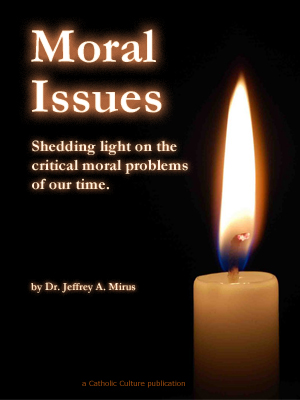Abortion in America: Legal & Unsafe
According to Planned Parenthood, abortion can be "a positive experience." Children must be taught not only that abortion is safe but also that pregnancy is dangerous. In It's Perfectly Normal, a sex-education book for ten-year-olds, Planned Parenthood's Robie Harris gives children nine reasons to have an abortion. She gives them no reason not to have an abortion.
At an International Planned Parenthood Federation conference, Deborah Rogow of the International Women's Health Coalition told delegates that "the sharp distinction between abortion and contraception is more an ideological construction than a logical response to clients' needs" while consultant Marge Berer "denied that abortion is inferior to contraception as a means of birth control," and observed that "use of abortion for birth control may be preferable."
From ocean to ocean Planned Parenthood's representatives are invited into American schools to discuss "safer sex," which, the speakers are careful to assure our children, means that contraception "works." The speakers also contend that abortion is "simple and painless" and a "safe" solution to their problems.
How "safe" is abortion? American records relating to abortion injuries, if they exist at all, are not publicly reported, but the emergency rooms of metropolitan hospitals daily confront the damage done to aborting women: hemorrhage, perforated uterus, septicemia, and more. A survey of American obstetricians published in Your Body Ecology found that 87 percent have hospitalized women due to serious complications following legal abortions. Indeed, the problem is so serious that the Accreditation Council for Graduate Medical Education has revised its rules to require that all obstetric residents be provided "experience with management of complications of abortion," whether or not abortion is part of their training.
Abortion damages the subsequent general health of aborted mothers. At the request of the Virginia Legislature, the Virginia Department of Medical Assistance Services reported that among women receiving state aid, those who gave birth to children were much healthier than those who aborted them. "The women with normal deliveries had 307 claims for subsequent health interventions. The women with legally induced abortions had 532 claims for subsequent health interventions." In terms of dollars spent: "The women with normal deliveries cost the state $66,000 for health interventions; those who had an abortion cost the state $123,800."
Ectopic pregnancy has now become a leading: cause of maternal mortality. In 1970, 17,000 ectopic pregnancies were reported. By 1987 that number had grown to 88,000. Ectopic pregnancy is a common "consequence of uterine injuries consecutive to [abortion]," and often results from "inflammatory lesions or asymptomatic ascending infections, which damage the fallopian tubes causing the embryo to implant in the tube" (The American Journal of Public Health). It's not surprising that, as reported by The Lancet, "the country with the lowest [maternal] mortality in the world is the Irish Republic, with a rate of 1.83 per 100,000 live births. Ireland is the safest place in the world to have a baby; this was achieved without having legal abortion."
Another complication of abortion is subsequent infertility, a rare condition a generation ago. A study by Toronto General Hospital found that one-third of teenagers undergoing abortion "suffered complications jeopardizing later fertility." Couples in the U.S. now spend billions of dollars every year in fertility clinics.
Saddest of all is the death of babies during subsequent births. A 1986 National Institutes of Health study of 40,000 women, half of whom had had abortions and half of whom had carried their first babies to term, found that women who had aborted their first babies later lost babies during birth almost twice as often as those who had previously given birth. Those who had previously aborted later experienced an 85 percent increase in miscarriages, a 67 percent increase in premature births, a 47 percent increase in labor complications, and an 85 percent increase in delivery complications.
We are, of course, repeatedly reminded by the media that women are happier now that abortion is legal. In its Internet celebration of Roe v. Wade, Planned Parenthood emphasized the emotional benefits of abortion: "The emotion most women experience after an abortion is relief. Some people who are opposed to abortion claim that most women who have an abortion suffer severe and long-lasting emotional problems. They call these problems 'post-abortion syndrome.' But this syndrome is not recognized by the American Psychological Association."
Were Planned Parenthood to be candid, it would say that the syndrome is no longer recognized by the APA. Until recently the Association's Diagnostic and Statistical Manual of Mental Disorders-III-Revised listed abortion as a "psycho-social stressor" with symptoms identical to symptoms of post-traumatic stress disorder. But since 1994 all references to abortion were purged, because the APA has become "politically correct"
Removing the symptoms from the manual, however, did not cure the victims. According to a study comparing the stress reactions to abortion in American and Russian women (reported in Care-Net Communications Briefs): "On an index scale of stress, post-abortive women rank higher (more stressed) than battered women."
Dr. Anne Catherine Speckhard of the University of Minnesota conducted an extensive study on "long-term manifestations of stress from abortion." Though the women she studied came from diverse backgrounds, they reported similar reactions. Four out of five reported "preoccupation" with the aborted child. Three-fourths reported "flashbacks of the abortion experience." Half had had nightmares, a third had had "perceived visitations from the aborted child," and a quarter had "hallucinations."
As one would expect, serious social problems ensue from these severe stress reactions. An Elliot Institute study established a strong statistical correlation between abortion and subsequent drug or alcohol abuse. The study (limited to women who had never had a substance abuse problem prior to their abortion) found that "those who aborted their first pregnancy were 3.9 times more likely to engage in subsequent drug or alcohol abuse than those who have never had an abortion."
Dr. Barry Garfinkel, chief of child and adolescent psychiatry at the University of Minnesota, conducted a study of 3,500 high school students in southern Minnesota "to determine what factors contribute to stress, depression and suicide in youngsters outside the metropolitan area." He was startled to find that teenage girls who had recently had an abortion were ten times more likely to attempt suicide than girls who hadn't A similar study by Finland's National Research, and Development Center found that within one year "the suicide rate after an abortion was three times the general suicide rate and six times that associated with birth" (British Medical Journal).
Dr. Phillip Ney confirmed this reaction in "The Effects of Pregnancy Loss on Women's Health" (Social Science Medecine): "Pregnancy losses: of all types have a deterious effect on women's health. This is most true of abortions, which may be most difficult to grieve, partly because of the intensity of the conflict...."
Dr. Ney also observed that abortion often results in an inability to bond with later children. In "Infant Abortions and Child Abuse Cause and Effect" (Canadian Journal of Psychology), Ney wrote that "(Abortion] is the cause of the increase in battering and murdered children.... [It] diminishes the social taboo against aggressing the defenseless and truncates mother-infant bonding with diminished future mothering capability." Since 1973, child abuse in the U.S. has risen over five hundred percent.
But isn't abortion "safe"? In the U.S. few deaths are officially reported as resulting from abortion, though many certainly occur. In Sweden, where all abortions are done in hospitals and follow-up care is mandatory, studies report 39 deaths per 100,000 abortions. Since fewer than ten percent of abortions in America are done in hospitals, and American abortion mills are notoriously ill equipped and unhygienic, one would expect a higher rate of mortality here than in Sweden. Unofficial studies indicate that to be true. No, abortion is not "safe."
Joseph Collison is the Director of the Office of' Pro- Life Activities for the Diocese of Norwich, Connecticut, and Chairman of the Board of Caring Families Pregnancy Services. He also writes for the Four County Catholic, the diocesan newspaper of Norwich.
© New Oxford Review, 1069 Kains Ave., Berkeley, CA 94706, 510-526-5374.
This item 2951 digitally provided courtesy of CatholicCulture.org






